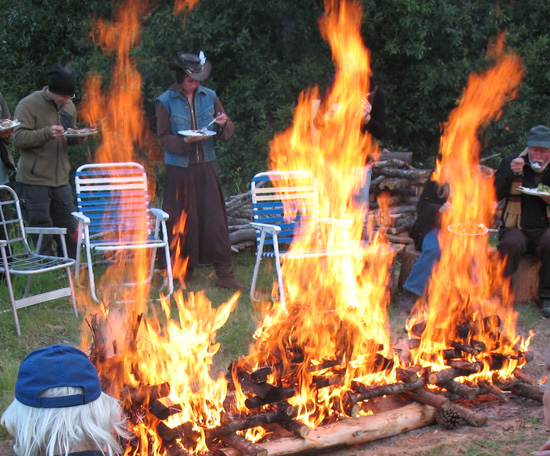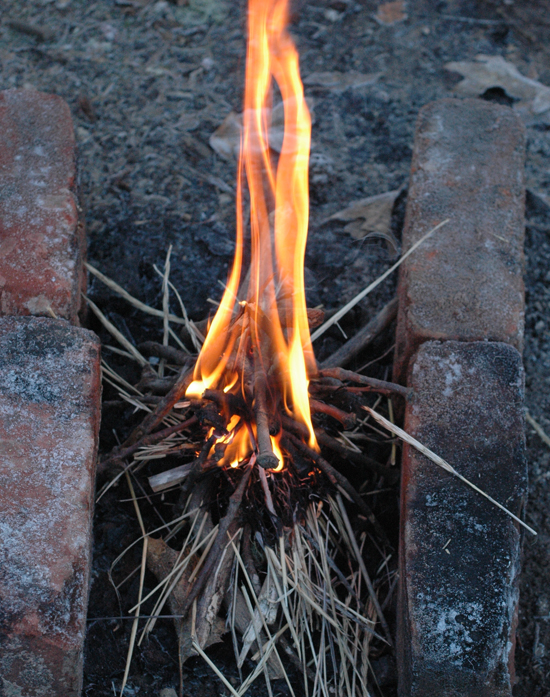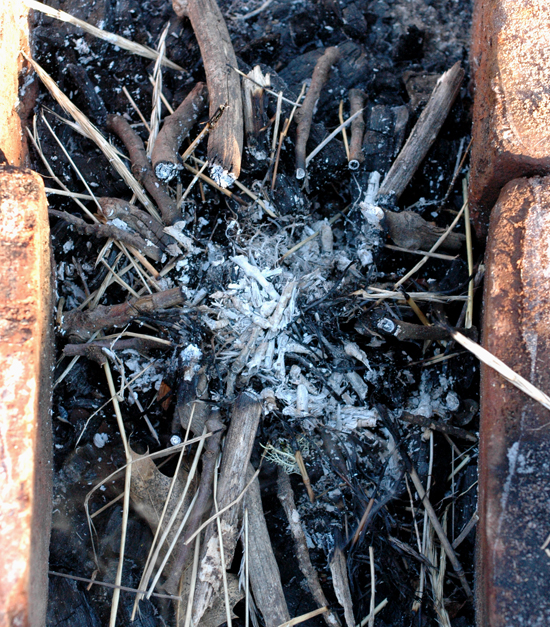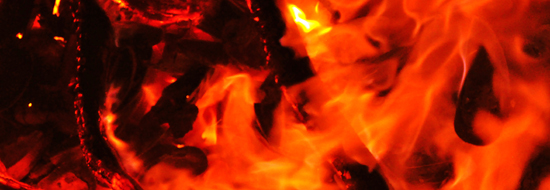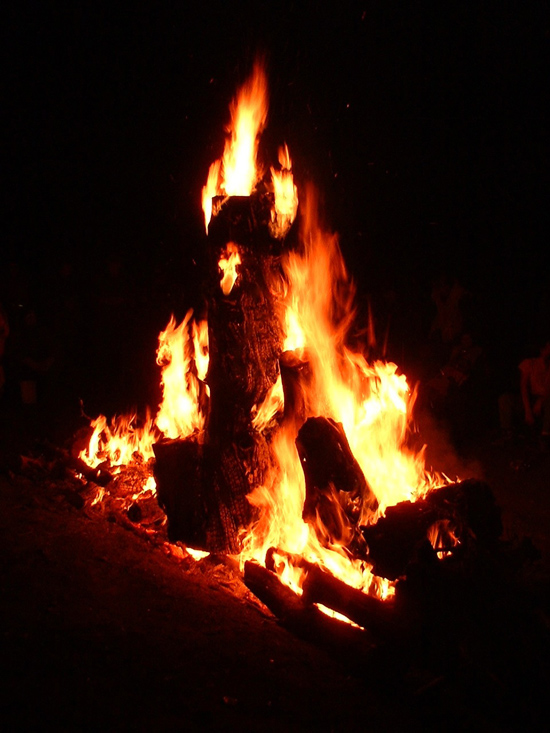Fire is an interaction between Heat, Fuel and Oxygen completely dependent on proportions, conditions and physical relations. It is not a self controlling, self adjusting system created to serve us; no, that it is not. What fire really is, is a sometimes beautiful, sometimes terrifying expression of physical laws, chemistry and energy which can serve us without intention or harm us without malice. Fire is the product of a universe which we can understand functionally and work with; one which does not judge, reward or punish.
By Steven Edholm
Hey all you pyros! I wrote this a while ago. I was going to take some relevant pictures and make it more of a tutorial, but I think it stands pretty well on it's own and video might just be a better format to explore some of the details. So here it is in all it's theoretical, abstracted glory.
We've all heard of the three things it takes to make a fire… HEAT, FUEL and OXYGEN. While it’s true that these are essential elements of fire, it is also true that without a fourth and equally important requirement there is no fire! Understanding this fourth requirement is key to effectively starting, controlling, utilizing and maintaining fire. It can be understood both logically, and intuitively through experience. It is the underlying and unifying principal of fire and no more or less dependent on the other three elements than they are on each other. And what is the secret ingredient? Drum roll please: The secret is simply the sphere of circumstances in which the heat fuel and oxygen exist, which allows the chain reaction to continue or vary in quality. Put more simply, we have to put heat, air and fuel together effectively to make fire happen and continue. And then, to expand a little further, how heat, fuel and oxygen are put together, the condition each is in, and the quantity of each affects the characteristics of the fire. Simple? Basically yes, but it is still something of a journey from that simple idea to effectively maintaining and managing fires for various uses. When you factor in the many circumstances which contribute to or detract from this chain reaction and consider that we want different types of fires for different purposes it becomes less simple, but then so much more compelling! Join me in exploring a few details of this sphere of circumstances, because it is the details, some of them minute, that make the difference in how (or even whether) a fire burns.
There is a model that is use to explain fire called the tetrahedron of fire. It is a 3 dimensional pyramid with 3 sides and a bottom. The three sides represent one each of heat, fuel and oxygen. The bottom represents an uninhibited chain reaction, or the fourth element. This fire model used to consist of only three parts, fuel, heat and oxygen, represented as a one dimensional triangle, but it was modified to represent the fact that fire does not exist without the proper relationship of the three tangible elements. Thus, the tetrahedron roughly represents what I am trying to tell you, which again is that fire exists and varies within a sphere of changing and interdependent circumstances. However, the tetrahedron model is so simple that it begs description and actually communicates nothing without additional information and explanation. I suppose that the series of articles I hope to write, and of which this is the first, will partly be that explanation and information from a practical standpoint, and of use to laypeople like us. I would like to see a fire model communicate some practical details, but my attempts to make a better model or diagram have been a fail. I suppose that the simplicity of the tetrahedron model may sometimes be an asset as it does not describe any one of the many types of fire. On the other hand the model is unable to communicate in any way the manner in which a fire functions and far too little about how it can be modified and controlled toward practical ends. I find that the tetrahedron model has little practical use here beyond what I’ve already discussed.
HEAT, OXYGEN AND FUEL DOES NOT ALWAYS A FIRE MAKE: When I was 20 something I was on top of maintaining fires at public gatherings and such. Now I'm inclined to sit back and let some eager, enthusiastic youngster do the job…. but they often don’t, which kind of sucks. I still often find myself raising my creaking, cold butt from the lukewarm side of some smokey waning fire to go fumble around in the dark for some firewood. If I'm patient or stubborn enough to wait for someone else to get up to add wood to the fire or, often more importantly, make adjustments to the wood that is already in the fire, my patience is not often well rewarded. Frequently, the poorly selected (… if selected isn't even just too strong a word to use lol) wood is added haphazardly or with an evident lack of understanding. All too often the new wood is somewhat randomly thrown on often creating more problems than there were in the first place. Kids today… sigh… Adding more fuel to the fire or just blowing on it does not fix everything. Fire is an interaction between Heat, Fuel and Oxygen completely dependent on proportions, conditions and physical relations. It is not a self controlling, self adjusting system created to serve us; no, that it is not. What fire really is, is a sometimes beautiful, sometimes terrifying expression of physical laws, chemistry and energy which can serve us without intention or harm us without malice. Fire is the product of a universe which we can understand functionally and work with; one which does not judge, reward or punish. Understanding a little fire theory can go a long way in enabling us to create, control and influence fire.
No, fire is not just Fuel, Heat and Oxygen, but in a very real way it is a product of specific relationships between those three elements which allows them to undergo the continuing chain reaction of combustion. Lets look quickly at some varying conditions:
*If you have the heat of a match a foot away from some well sized and placed fuel, even with oxygen all around in the air, you do not have fire.
*let us say that you have a big round log being heated with a propane torch while surrounded by air. Thats a lot of heat, and plenty of air, but in most circumstances the log on its own will not really flame a whole lot, it will more likely smolder and eventually go out after the heat is removed. If we add another log or some smaller fuel, in the proper spatial relationship, our big round log will burn more quickly, more thoroughly and longer, basically because of the interaction of the burning fuel units with each other. They heat each other and bounce heat back and forth.
*If we have a healthy fire burning away and add a quantity of very green moisture laden wood, the fire will falter and slow down mostly due to the effect of the moisture on the factor of heat.
*Throw a bucket of water on the fire and so much heat will be removed as steam to heat the water that the fire is likely to go out completely.
*Cram the logs in a fire too close together or smother it with dirt and you will not have enough oxygen for a healthy blaze.
*Move the logs too far apart from each other and they will not contribute to a mutual build up of heat between them and are likely to smolder and each may eventually just stop flaming, begin to smolder and eventually just go out.
All of the above examples illuminate the importance of specific relations between the three concrete elements of fire.
Fires have almost living characteristics. Like a living body, fires that we use to our ends often need attention and feeding to achieve certain goals. Maintaining and using fire effectively is all about details and the details that make a very functional fire can be very subtle and minute. No one really taught me to use fire properly. I learned by immersion. The lifestyle I chose demanded that I understand combustion enough to maintain an acceptable level of functionality. If I couldn't make a fire quickly with damp wood I wasn't going to finish cooking dinner before dark. If I managed the fire poorly every night I was going to wake up with sore eyes and a woodsmoke hangover. By the time Mors Kochanski introduced me to the tetrahedron of fire model I already understood it functionally, but had never put it all into place with symbology. I ultimately can't teach anyone either. Understanding fire functionally and not just theoretically is a personal journey. I can maybe start the fire for someone, but their enthusiasm, action, intention and maybe most of all need to keep that fire going, are what will ultimately create a functional understanding. Fire is fascinating to all people on some level, but most modern people do not find enough use for it to manifest a good working knowledge. If you want to understand fire functionally and stay in practice, there is no better way than to place yourself in a position of need on a regular basis. Start fires regularly, and start them from scratch never using paper or accelerants.
The simple but important information I've just presented above forms the foundation of a good working relationship with fire. Whether you are starting, managing or putting out fires, you are ultimately balancing or working mostly with the following concepts:
FUELS
*Conditions (wet, rotten, dry, warm etc…)
*Structure (dense, pithy, liquid, gaseous, etc…)
*Composition (Lignin content, chemistry, growth rate, environment, species etc…)
*Sizes
*Shapes
*Spatial distribution (relation of fuel units to each other and to heat source)
*Flamability
AIR
*Access or lack of
*Heat generated drafts
*Air temperature
*Air density
HEAT
*Temperature
*Radiation
*Proximity
*Reflection
*Blocking
*Placement of
I know that information is rather abstract, but you don't have to be a total dorkus like me and memorize it all or anything! I'm just using the theory to plant seeds that can lead to a functional and intuitive understanding of fire, because that is really where it's at. When there is an impetus to learn, and these basic ideas are presented in context, people's ability to manage a fire rises very rapidly, within minutes actually. I've seen this happen over and over when playing fire chess with students and friends. I hope to write more in this realm and put theory into context with either videos or more blog posts, so stay tuned.
One last thought, its easy to get cocky about ones understanding of fire. The truth is though that the factors which contribute to a given fire burning or not burning are complicated and not always easy to predict. However well we think we know it, fire can sometimes surprise us. Considering the often horrific consequences of uncontrolled fire, it is best to follow the precautionary principal when it comes to safety, and err on the side of caution.
Have something to add? Did I miss something important? Leave a comment.


